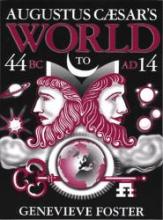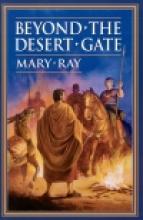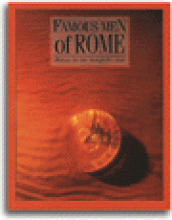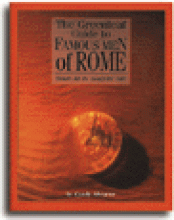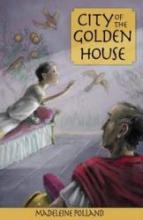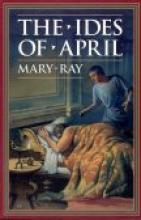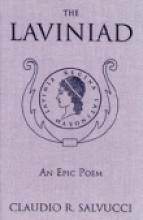Ancient Rome
Augustus Caesar's World
Subject(s):
Setting:
Grade / Age level:
Resource Type:
Review:
We've found "Augustus Caesar's World" by Genevieve Foster to be a wonderful resource. The book covers the period from 44 BC to 14 AD with events and ideas for that time, all over the world. I feel the stories really give my son a great sense of life during this period. The illustrations are outstanding line drawing of characters, maps and especially the time lines. Just wanted to share a great resource.
Note from the Webmaster: A number of Catholic homeschool parents have commented that the book has some problematic sections of a secular nature - soft on paganism, etc. It may well be a worthwhile book, but should only be used with a reasonable amount of caution and parental supervision.
Note from the Webmaster: A number of Catholic homeschool parents have commented that the book has some problematic sections of a secular nature - soft on paganism, etc. It may well be a worthwhile book, but should only be used with a reasonable amount of caution and parental supervision.
Additional notes:
Copyrights 1947/1996
Reviewed by:
First reviewed:
1998-99
Beyond the Desert Gate
Subject(s):
Setting:
Grade / Age level:
Review:
Set in Palestine in the days leading up to the fall of Jerusalem in 70 A.D., this is a beautiful and powerful story of a Greek family living in the city of Philadelphia. On one of his business journeys, their father, who is a merchant/businessman, rescues a man whom Roman soldiers had left in the desert to die. The merchant's three sons have diverse reactions to this stranger who becomes part of the household, but when the Father is killed by bandits on a later journey, it seems that this stranger without a memory may have a providential role in their future.
The story illustrates the struggles of those caught up in the brutality of Roman rule, the horror of the fall of Jerusalem and touches upon the mysteries of suffering and death. While dealing with the different sorts of reactions that people have to the evils of Rome, the story does highlight - albeit in a subtle way (as good literature should) - the true paths that Christ showed us. An especially interesting contrast can be seen between the courage of the Christians before death (inspired by Christ and given his grace) with the Jews rebelling against Rome (whose motivations involved patriotism, but also hate).
The story is not overly intense, gory, or otherwise objectionable, but dwells upon serious and mature themes of death and suffering in a way suitable to teens and adults. Although the book is a sequel to The Ides of April (which is not apparent until well into the book), it could be read on its own as well.
The story illustrates the struggles of those caught up in the brutality of Roman rule, the horror of the fall of Jerusalem and touches upon the mysteries of suffering and death. While dealing with the different sorts of reactions that people have to the evils of Rome, the story does highlight - albeit in a subtle way (as good literature should) - the true paths that Christ showed us. An especially interesting contrast can be seen between the courage of the Christians before death (inspired by Christ and given his grace) with the Jews rebelling against Rome (whose motivations involved patriotism, but also hate).
The story is not overly intense, gory, or otherwise objectionable, but dwells upon serious and mature themes of death and suffering in a way suitable to teens and adults. Although the book is a sequel to The Ides of April (which is not apparent until well into the book), it could be read on its own as well.
Perspective:
Catholic
Additional notes:
Copyrights 1977/2001
Reviewed by:
First reviewed:
4-23-01
City: A Story of Roman Planning and Construction
Number of pages:
112 pages
Copyright:
1974
Publisher:
HarperCollins
Binding:
Sewn Softcover
Subject(s):
Setting:
Grade / Age level:
Review:
Artist, author and scientist David Macaulay presents a fascinating account of the founding, building and development of a fictional Ancient Roman city. Don't be thrown off by the "fictional" part. We don't know this many details of any particular Roman city, so the author has gathered facts and details from various cities and formed them into one complete story. They are carefully researched and accurately portrayed in detailed black and white drawings. The focus is on how the architecture works (Roman Arches, aqueducts, layout, plumbing, etc.) but also covers quite a bit of historical and cultural information. Although the text is geared toward mid to upper grade school, it will be enjoyed by younger children as a read aloud and is suitable for older readers as well.
Additional notes:
Various editions available
Reviewed by:
First reviewed:
2-27-01
Famous Men of Rome
Subject(s):
Setting:
Grade / Age level:
Review:
Our first year of homeschooling we used a dry textbook for American history. Well, we didn't really use it - we put it off as much as possible and the year passed with only the first few chapters read.
Our second year of homeschooling, we discovered Greenleaf's Famous Men series (through enrolling in the Kolbe Academy Home Study program). What a difference! It was our first exposure to literature-based history study, and the idea of studying time periods through "real books" was a formative one in our homeschool.
Famous Men of Rome was written very early in the 20th century and revised by Rob Shearer of Greenleaf Press. Its operating principle is that history is not primarily about dates and facts; it is about the lives and actions of people. Consequently, it is divided into a series of "Lives", chronologically arranged, simply and memorably telling of the lives and choices of leaders and great men in the history of Rome.
There are thirty chapters in the book, starting with Rome's origin according to legend: the story of Romulus and Remus and their upbringing by a wolf, which became the symbol of Rome's self-identity in its later years. The rest of the book focuses on one historical "famous man" per chapter, with approximate dates of their lives. The stories are told as tales of virtue and vice and how individual actions and characters can affect history, not as dry collections of historical facts to memorize. My highschooler still remembers, from fifth grade, Horatio at the bridge and Cicero ending every speech to the Senate with "And Carthage must be destroyed!" The chronological range of the book is from 753 BC, the estimated founding of Rome, to 476 AD, the end of the Western Empire as Italy became a barbarian kingdom under the rein of Odoacer.
Though the stories in Famous Men of Rome are almost always very interesting, the writing style is quite simple. This might be a drawback to some families who prefer a more literary, complex style. But it does mean that an average 5th grader can read with comprehension and focus on content and meaning. Another possible criticism might be that taken by themselves, the Lives give a sort of scattershot perspective of the course of history - like a slideshow compared to a video. However, in my view the biographical presentation gives history more meaning and interest, and also allows us to compare and contrast the characters of these great men and see how their actions influenced their times.
The book is probably targeted to a third to seventh grade level. It makes an excellent read aloud, but can also be read independently. Kolbe Academy uses it for the history spine in fourth grade. An older student could read the book as an informative supplement to primary source reading in junior high to high school.
Our second year of homeschooling, we discovered Greenleaf's Famous Men series (through enrolling in the Kolbe Academy Home Study program). What a difference! It was our first exposure to literature-based history study, and the idea of studying time periods through "real books" was a formative one in our homeschool.
Famous Men of Rome was written very early in the 20th century and revised by Rob Shearer of Greenleaf Press. Its operating principle is that history is not primarily about dates and facts; it is about the lives and actions of people. Consequently, it is divided into a series of "Lives", chronologically arranged, simply and memorably telling of the lives and choices of leaders and great men in the history of Rome.
There are thirty chapters in the book, starting with Rome's origin according to legend: the story of Romulus and Remus and their upbringing by a wolf, which became the symbol of Rome's self-identity in its later years. The rest of the book focuses on one historical "famous man" per chapter, with approximate dates of their lives. The stories are told as tales of virtue and vice and how individual actions and characters can affect history, not as dry collections of historical facts to memorize. My highschooler still remembers, from fifth grade, Horatio at the bridge and Cicero ending every speech to the Senate with "And Carthage must be destroyed!" The chronological range of the book is from 753 BC, the estimated founding of Rome, to 476 AD, the end of the Western Empire as Italy became a barbarian kingdom under the rein of Odoacer.
Though the stories in Famous Men of Rome are almost always very interesting, the writing style is quite simple. This might be a drawback to some families who prefer a more literary, complex style. But it does mean that an average 5th grader can read with comprehension and focus on content and meaning. Another possible criticism might be that taken by themselves, the Lives give a sort of scattershot perspective of the course of history - like a slideshow compared to a video. However, in my view the biographical presentation gives history more meaning and interest, and also allows us to compare and contrast the characters of these great men and see how their actions influenced their times.
The book is probably targeted to a third to seventh grade level. It makes an excellent read aloud, but can also be read independently. Kolbe Academy uses it for the history spine in fourth grade. An older student could read the book as an informative supplement to primary source reading in junior high to high school.
Reviewed by:
First reviewed:
7-19-04
Galen and the Gateway to Medicine
Subject(s):
Setting:
Grade / Age level:
Review:
Jeanne Bendick's second title in Bethlehem Books' "Living History" series (after Archimedes and the Door of Science) brings to life the 2nd century (A.D.) Roman doctor whose work in learning to understand the human body became the standard authority on human physiology for over a thousand years. Although many of his theories were corrected through advancements in science since the middle ages, his story is interesting both for its own sake and for the light is sheds on Roman history and culture and the Hippocratic tradition of medicine.
Galen was born in 129 A.D. in present day Turkey (at that time part of the Roman Empire). When he studied medicine, medical training was very haphazard, but in his lifetime he revolutionized the idea of what a doctor should be, both by his example as a renowned doctor and his extensive writings on anatomy and pharmacology (some of which are still in existence today). His experience in treating patients from wounded gladiators to the wealthy of Rome to Roman emperors, extensive study of medicinal plants, dissection of animals, etc. led to his remarkable success as a doctor and the respect with which his writings were treated.
The medical aspects of the book largely focus on the quest to understand the purpose of each of the organs and the workings of the circulatory system. The author also provides us with a final chapter which summarizes the medical advancements after Galen that led to our current understanding of how the body works. Like Archimedes and the Door of Science, this story will be best understood by ages ten and up and takes a certain amount of concentration to follow the story and absorb its content well. However, the rewards are great in acquiring a deeper understanding of Roman culture, medicine, and the respect for life that has been passed down from the Hippocratic tradition.
Galen was born in 129 A.D. in present day Turkey (at that time part of the Roman Empire). When he studied medicine, medical training was very haphazard, but in his lifetime he revolutionized the idea of what a doctor should be, both by his example as a renowned doctor and his extensive writings on anatomy and pharmacology (some of which are still in existence today). His experience in treating patients from wounded gladiators to the wealthy of Rome to Roman emperors, extensive study of medicinal plants, dissection of animals, etc. led to his remarkable success as a doctor and the respect with which his writings were treated.
The medical aspects of the book largely focus on the quest to understand the purpose of each of the organs and the workings of the circulatory system. The author also provides us with a final chapter which summarizes the medical advancements after Galen that led to our current understanding of how the body works. Like Archimedes and the Door of Science, this story will be best understood by ages ten and up and takes a certain amount of concentration to follow the story and absorb its content well. However, the rewards are great in acquiring a deeper understanding of Roman culture, medicine, and the respect for life that has been passed down from the Hippocratic tradition.
Reviewed by:
First reviewed:
2-3-03
Greenleaf Guide to Famous Men of Rome
Subject(s):
Setting:
Grade / Age level:
Review:
The Greenleaf Guide to Famous Men of Rome is an optional supplement for the book. It includes, for each lesson, a vocabulary list and several discussion questions designed to bring out the key points of each biography through a Christian (biblical) perspective. The discussion questions are excellent narration starters and really do help bring out the theme that "individual people and their actions have a significant effect on history". There are some ideas for simple hands-on projects (the first lesson involves making a salt relief map of the country in question to get an idea of how geographical circumstances affect history). There are also suggestions for supplementary reading. I must say their book choices are quite wonderful and that all the books we acquired on Greenleaf's recommendation for ancient history have been treasures. There is also a timeline at the back which is helpful in unifying the various biographies.
Reviewed by:
First reviewed:
7-19-04
The City of the Golden House
Subject(s):
Setting:
Grade / Age level:
Review:
Reviewed by:
First reviewed:
12-29-06
The Ides of April
Subject(s):
Setting:
Grade / Age level:
Review:
When Hylas, a slave, discovers the death of his master, a Roman senator, he realizes that he is in dire straits. The harsh laws of ancient Rome dictate that all household slaves be killed should a murder be discovered in that home. Hylas enlists the help of Camillus Rufus, a tribune, to help clear the slaves of the judge's inevitable verdict of 'guilty!'
The Ides of April is an intriguing book set in 62 A.D. It's a classic murder mystery. The author, Mary Ray, paints a vivid picture of life in ancient Rome. Students will gain much technical information about the time period - social status, architecture, religion, laws, the games, and the working of a household.
Though the book is recommended for children "14 years and up", younger children would enjoy it as a read-aloud. It's on the "highly-recommended list" at our house.
The Ides of April is an intriguing book set in 62 A.D. It's a classic murder mystery. The author, Mary Ray, paints a vivid picture of life in ancient Rome. Students will gain much technical information about the time period - social status, architecture, religion, laws, the games, and the working of a household.
Though the book is recommended for children "14 years and up", younger children would enjoy it as a read-aloud. It's on the "highly-recommended list" at our house.
Additional notes:
Copyrights 1974/1999
Reviewed by:
First reviewed:
1998-99
The Laviniad
Subject(s):
Setting:
Grade / Age level:
Review:
The Laviniad is a truly unique work; the story is unique and the book itself is unique.
First the story: The author successfully writes in the style of the ancient epic in modern English, picking up the thread of the story of the Aeneid. The Laviniad takes up the tale of the Trojan settlement of Latium following the death of Aeneas. His son, Ascanius, assumes the leadership and almost immediatley must deal with the threat of Italians still hostile to the Trojan presence.
There are some pleasant similarities to the ancient epics, such as prophecies that are fulfilled in not quite the way the people expect, and the descriptions of the deaths of the heroes. The Trojans prevail in the end and Lavinia, Aeneas' widow gives birth to his child, the true and final mix of the blood of the Latins and the Trojans. Hope is restored to a people wearied by years of war and loss of life. Lovers of classic tales will really appreciate the poetry and the plot.
The poem reads easily and naturally with the flow and flavor of the ancient epics. A complete glossary in the back will help anyone who has not read the Aeneid or the Iliad to understand the relationship of the characters and the various names of the Greeks, Trojans, and Latins. It is not, strictly speaking, a sequel, however, a knowledge of the events of the Aeneid is helpful. A highschooler could appreciate the story whether or not he has read the Aeneid.
Now the book: I learned from the publisher that the author hand makes each book, binding and all! The story is printed on parchment and handsewn, not glued. The outer cover is a light blue cloth cover. It is a beautiful, elegant edition, wonderful for gift giving.
First the story: The author successfully writes in the style of the ancient epic in modern English, picking up the thread of the story of the Aeneid. The Laviniad takes up the tale of the Trojan settlement of Latium following the death of Aeneas. His son, Ascanius, assumes the leadership and almost immediatley must deal with the threat of Italians still hostile to the Trojan presence.
There are some pleasant similarities to the ancient epics, such as prophecies that are fulfilled in not quite the way the people expect, and the descriptions of the deaths of the heroes. The Trojans prevail in the end and Lavinia, Aeneas' widow gives birth to his child, the true and final mix of the blood of the Latins and the Trojans. Hope is restored to a people wearied by years of war and loss of life. Lovers of classic tales will really appreciate the poetry and the plot.
The poem reads easily and naturally with the flow and flavor of the ancient epics. A complete glossary in the back will help anyone who has not read the Aeneid or the Iliad to understand the relationship of the characters and the various names of the Greeks, Trojans, and Latins. It is not, strictly speaking, a sequel, however, a knowledge of the events of the Aeneid is helpful. A highschooler could appreciate the story whether or not he has read the Aeneid.
Now the book: I learned from the publisher that the author hand makes each book, binding and all! The story is printed on parchment and handsewn, not glued. The outer cover is a light blue cloth cover. It is a beautiful, elegant edition, wonderful for gift giving.
Additional notes:
Binding details: Hardback with cloth covering
Reviewed by:
First reviewed:
8-12-04

